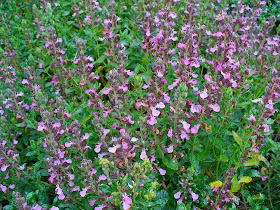 Veronica officinalis - Common Speedwell
Veronica officinalis - Common SpeedwellSpeedwell is a small perennial herb that grows 6 to 12 inches high with tiny, oval flowers of pale blue, lavender and white. Native to Europe, but now growing globally, the plant has long been used medicinally. The stems leaves and roots are all used.
is a small perennial herb that grows 6 to 12 inches high with tiny, oval flowers of pale blue, lavender and white. Native to Europe, but now growing globally, the plant has long been used medicinally. The stems leaves and roots are all used.
Historically considered a panacea, herbalists used speedwell for a variety of symptoms and it was considered a medicinal staple. The herb is a favourite addition to teas that cleanse the blood and with the tops of fresh Stinging Nettle, it heals chronic eczema. It is especially recommended for the itchy skin suffered by the elderly. Extracts are widely sold as herbal remedies for sinus and ear infections. It is also found in sunscreen, moisturizers, and hair products.
 It was used to treat jaundice, gravel in the bladder, rheumatism and gout. Memory lapses disappeared after drinking tea, prepared of equal amounts of Speedwell and Common Horsetail
It was used to treat jaundice, gravel in the bladder, rheumatism and gout. Memory lapses disappeared after drinking tea, prepared of equal amounts of Speedwell and Common Horsetail Some people eat speedwell raw in salads or add it to soup. An infusion of Speedwell
Some people eat speedwell raw in salads or add it to soup. An infusion of SpeedwellSpeedwell is easy to grow, it lives a long time, and likes a well drained soil that can retain moisture in summer. It can do well in sun or light shade. Deadheading (removing dead flower tops) will encourse new growth and more flowers. When the plant starts to overcrowd itself and lose vigor, divide clumps of it in the spring when it starts to emerge.
Teucrium chamaedrys - The Common Germander is a native of many parts of Europe , the Greek Islands and also of Syria, being found near Jerusalem
, the Greek Islands and also of Syria, being found near Jerusalem . But in England it is scarce and hardly indigenous being found only on the ruins of old buildings and in other places where it has escaped from cultivation. It was formerly much cultivated in this Britain
. But in England it is scarce and hardly indigenous being found only on the ruins of old buildings and in other places where it has escaped from cultivation. It was formerly much cultivated in this Britain for medicinal purposes.
for medicinal purposes.
The name chamaedrys comes from chamai (ground) and drus (oak). The name Germander is considered also to be a corruption of Chamaedrys. The French call this plant Petit Chêne (Germander), from the shape of the leaves, as well as Chasse fièvre (Drive out fever), from its use in medicine. Germander belongs to the Mint family (Lamiaceae). And an unusual feature of this genus is that the flowers completely lack the upper lip of the corolla (petal).

In the 1600's, Germander was used with honey to heal ulcers, and made into an oil for eye ailments. The powdered seeds were good against jaundice, and when in flower, the tops were steeped in white wine for 24 hours adn used to destroy intestinal worms. The extract, taken for four days, cured malaria. It was also good against diseases of the brain, headache, falling sickness (epilepsy) , melancholy, drowsiness and dullness of spirits, convulsions and palsies.
Germander is a low-growing evergreen perennial, which makes it an ideal hedge plant. It will grow in almost any soil and is propagated by seeds, But its best to buy plants because it can take up to 30 days to germinate. It is very easily propagated by cuttings taken in spring or summer, and by division of roots in the autumn. Plant about a foot apart each way.
 Germander can be kept clipped to 12 inches for a tighter structure, or allowed to grow to a looser 24 inches. The roots are perennial and creeping, its erect square stem grows 6 to 18 inches with numerous leafy branches. It gets its name from its dark shiny green leaves which are about 1 1/2 inches long and indented like an oak leaf. The entire plant is hairy and the rose-coloured flowers bloom in June and July. It can be trimmed back after flowering and pruned to about 2 inches off the ground in spring.
Germander can be kept clipped to 12 inches for a tighter structure, or allowed to grow to a looser 24 inches. The roots are perennial and creeping, its erect square stem grows 6 to 18 inches with numerous leafy branches. It gets its name from its dark shiny green leaves which are about 1 1/2 inches long and indented like an oak leaf. The entire plant is hairy and the rose-coloured flowers bloom in June and July. It can be trimmed back after flowering and pruned to about 2 inches off the ground in spring.When you find a germander that you like, you only need to buy one because you can easily propagate more from cuttings. Because of its trailing habit, the plant's stems can be easily pinned to the ground and will automatically put out roots.
There is nothing better than Germander for bringing in the late-season bees. The Germander's purple flower spikes appear in late summer, and are the bee's bsolute favorites! They are drawn to the flowers in huge numbers. But the bees are helpful, not aggressive; they are so focussed on visiting the Germander flowers that they don't notice anything else.




No comments:
Post a Comment
I'm always happy to hear from my readers.